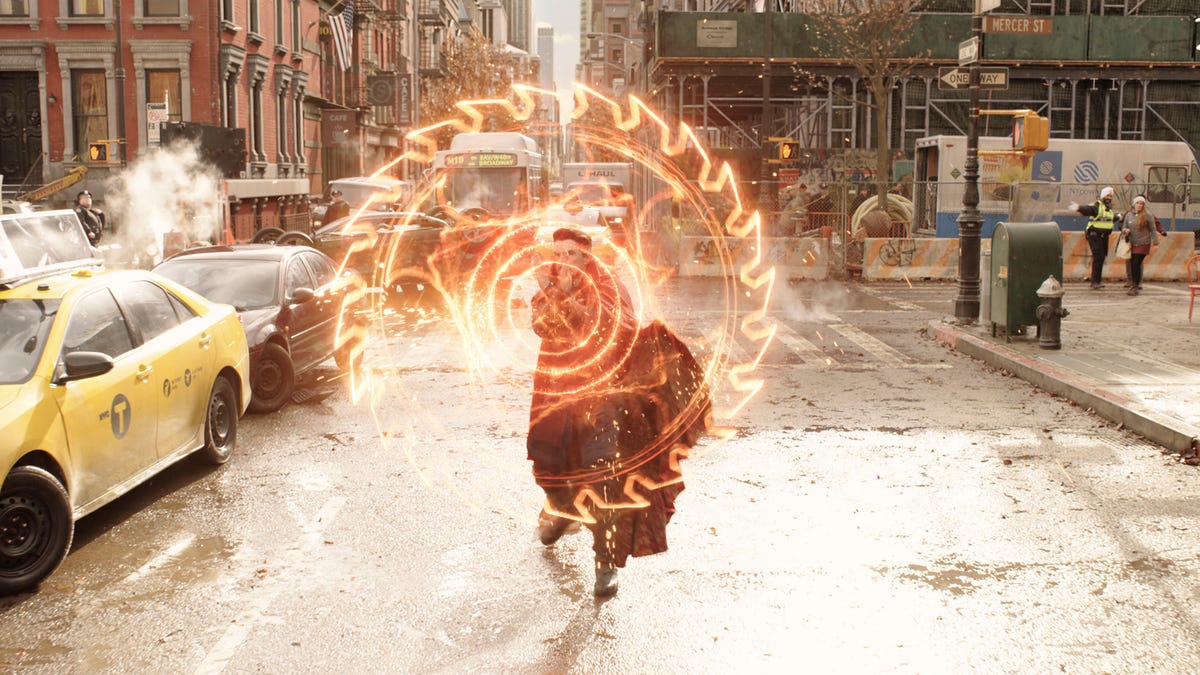The Problem With the Surprise Cameos in Marvel's 'Doctor Strange 2'
Commentary: As Doctor Strange in the Multiverse of Madness hits Disney Plus, we're running the risk of the multiverse and fan-service cameos making everything meaningless.

Benedict Cumberbatch stars in Marvel's Doctor Strange in the Multiverse of Madness.
When Toby Maguire and Andrew Garfield popped into Spider-Man: No Way Home as alternate universe Peter Parkers, I whooped. When the plethora of cameos showed up in Doctor Strange in the Multiverse of Madness, now available to stream on Disney Plus, it elicited a similar feeling of delight -- followed almost immediately by empty disappointment.
It's what I had feared: The massive success of No Way Home, which brought back Spider-Men from two previous franchises, has set off a trend of multiverse-inspired cameos. But No Way Home actually let us spend time with Maguire and Garfield, who brought ethos and emotion and formed a real connection with Tom Holland's Marvel Cinematic Universe version.
Doctor Strange's cameos don't fare as well.
I can't go on without going into SPOILERS, so here's your warning. We also have separate ending, post-credits and Illuminati explainers, as well as a list of WTF questions the movie left us with.
The most heavily hyped moment of the flick comes at around the midway point, when Doctor Strange finds himself in an alternate universe in which multiversal travel is well understood. This universe has set up the "Illuminati," a council stocked with fan favorite characters. Fans already expected to see Patrick Stewart as Professor Xavier, though the sight of him rolling into frame in his trademark yellow hoverchair, straight from the '90s animated series, drew excited squeals.
Then there was Hayley Atwell's Captain Carter, fresh from the premiere episode of Disney Plus's What If series, the surprise appearance of Anson Mount's Black Bolt from the quickly canceled and forgotten ABC series Inhumans, and Lashana Lynch as Maria Rambeau playing this universe's Captain Marvel.
The biggest cheer, however, came with the appearance of John Krasinski as Reed Richards, or Mr. Fantastic. Krasinski has long been a fan-favorite choice to play the classic Marvel character.
With an amazing mix of recognizable (Stewart) and fresh (Krasinski) faces, the Illuminati seemed poised to open a new chapter in the MCU, one that leads to different universes and exciting storytelling possibilities. Get ready for a wild ride, right?
None of the characters last 10 minutes.
Rather than explore these characters, as No Way Home did with Maguire and Garfield, the film uses the Illuminati as essentially cannon fodder, with Wanda Maximoff (Elizabeth Olsen) tearing through them in an effort to get to Dr. Strange (Benedict Cumberbatch) and America Chavez (Xochitl Gomez).
I admit it was entertaining to watch how they were dispatched (in a very typical Sam Raimi gruesome way... seeing Black Bolt's brain sort of pop made me cringe). But there was a feeling of emptiness that followed. All that potential had gone to waste. There aren't any stakes since you don't spend any time with these characters to care about what happens to them.
Sure, there's a chance we'll see some of these characters (probably in a Disney Plus show), or at least a version of them, but there was the sinking feeling that all that excitement and anticipation was for nothing.
Then I thought back to the last time I felt this way, and it was another Marvel property. Wandavision teased a potentially groundbreaking development when it introduced Evan Peters as Wanda's brother Pietro. Peters played a version of Pietro in the X-Men films, leading to speculation that this represented a crack in the multiversal walls that would introduce mutants in the MCU.
That wasn't to be, as the show revealed Peters as Westview resident Ralph Bohner, the subject of a groan-worthy and juvenile joke that made the fall harder as the rug was pulled from under us.
It's not the first time the MCU used our expectations against us -- Iron Man 3's Mandarin ended up being a comical actor played by Ben Kingsley.
But there are only so many times the MCU can play this card. We can only take so much emotional manipulation.
It's not just the MCU. Sony's Morbius teased the appearance of Spider-Man: Homecoming's Vulture (Michael Keaton) in commercials, but it ended up being a midcredits tease. We'll see how DC deals with the multiverse with the upcoming The Flash (which also brings back Keaton).
The use of cameos is powerful. The original Iron Man did it effectively with its end-credits tease of Samuel L. Jackson as Nick Fury. That opened the door to, well, all of the MCU and the countless stories that followed.
But we're at a place where the cameo is everything, even if it's just a gag or a tease with no payoff. No Way Home showed there's a way to utilize fan-pleasing appearances to improve the storytelling and character-building experience. My plea to Hollywood is: Don't go down the lazy route of cameos for the sake of cameos. We deserve better.

